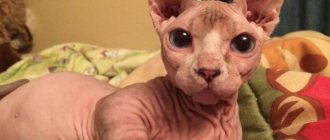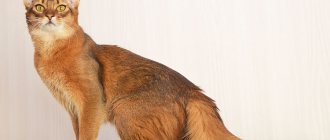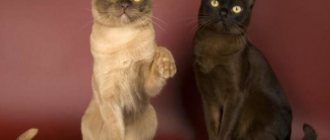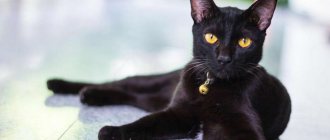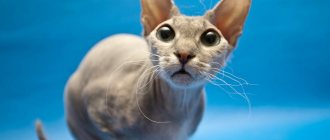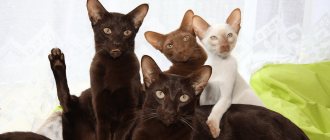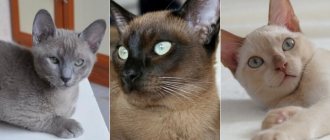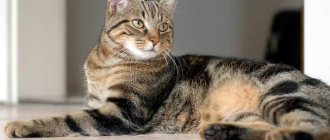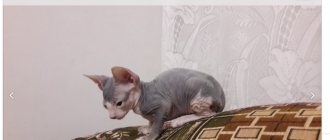This unique breed has many advantages that a person may not even be aware of. The photo of an oriental cat does not look quite ordinary.
At first glance, the appearance of thin cats with long ears may seem comical, but in fact, representatives of this breed have a wonderful character that owners cannot help but like.
A little history
In the 19th century, the Siamese cat became a guest at an English exhibition, where its appearance became a real sensation.
Later, breeders began crossing Siamese with female shorthaired breeds. This is how the Oriental cat breed was developed.
Eastern cat and its features
The name of the representatives of the breed gives some idea of themselves, because from English “oriental” is translated as “eastern”, which makes the cat a rather mysterious breed.
Indeed, it is extremely difficult to find cats similar to oriental ones, because our world does not know many oriental species. For example, consider the Eastern Siamese, which, as an Oriental Shorthair breed recognized by the cat fanciers' association, has the distinguishing feature of only coat colors and different colored eyes. Also, compared to Siamese cats, the Oriental cat is distinguished by the absence of any special darker markings on the tail, face and paws that distinguish the Siamese cat from other cats. The Oriental cat has a uniform coat of pure colors throughout its body. Many features of these cats represent the best - taken from wild genetically inherent qualities, for example, Oriental cats are graceful, have a relief constitution, long and flexible bodies.
According to their conformational characteristics, oriental cats have long, elegant legs and a beautiful, rounded head. The cute, attractive face has large, expressive almond-shaped eyes and medium-sized ears. Cats captivate others with their proud posture, graceful plasticity of movements, grace and elegance.
Oriental
When buying a pet Oriental animal, you get, first of all, a friend who can be trained very well, since the Oriental cat carries out most of the complex commands, because cats also have high intelligence. The pet is immediately attached to its owners, sociable, sincerely loves and trusts. Your representative of the Oriental Shorthair will always find something to do and entertain himself; cats are quite curious, so almost everything that happens around them will be examined and investigated.
Pets will be members of your family, always helping and maintaining friendliness. If small children live nearby in a house where cats live, then oriental cats will happily entertain the children by playing with them. They do not understand that the baby wants to sleep and is generally still too small; they will persistently try to climb into his crib. Therefore, if you have a newborn baby, it is better not to adopt an oriental cat. She will be a great friend and playmate for older children.
Training a pet is in many ways perceived as a game, so the owner can easily teach the pet to perform many exciting commands.
Show cats that it is best to walk on a leash, due to their excessive activity and the danger of running away. While playing on the street, a cat of an oriental breed can easily be taught the “Fetch” command, by which it brings some object, a stick or a ball, thrown by the owner. Other inhabitants of the house or street where Oriental Shorthair cats live will definitely become friends, because the Oriental cat is a conflict-free cat, peace-loving and friendly.
Health
The cat’s immunity is strong, but Orientals are still susceptible to some diseases:
- Gingivitis. The disease is provoked by an infection that is located on tartar. Characteristic symptoms: bad breath, pet’s refusal to eat, excessive salivation. To avoid gingivitis, you should clean your cat's mouth regularly.
- Amyloidosis of the liver. This disease is hereditary.
- Progressive retinal atrophy. Both kittens and adults are susceptible to this disease. The disease goes unnoticed, without external symptoms. It can only be detected with the help of specialized veterinary equipment.
- Flat chest. This syndrome is typical only for kittens. A slight deformity is not so terrible; it can disappear on its own, because as the kitten grows, the chest expands. However, severe deformation can lead to the death of the pet.
- Cardiomyopathy. This is a heart disease characterized by shortness of breath and cough after vigorous play.
Oriental cats also need to be protected from drafts, because they have no undercoat. In the temperate climate of Russia (and Europe too), these cats often freeze (remember that their homeland is Thailand). They are not adapted to life on the street.
Characteristics of a pet
An owner who wants to get a pet will need the following information: the character and description of the oriental cat.
These energetic animals have a good disposition. Cats are trusting of people and quickly become attached to them. If the owner takes care of his pet, then he will always be surrounded by boundless love.
A sociable cat requires a lot of attention. If a person is constantly busy, he should not choose such a pet. Or he can get a couple of cats at once; the two animals will not be bored.
Among the characteristics of the breed, one can note a gentle voice; pets love to talk with people. Cats are always in a great mood and are ready to play with their owner as soon as he has free time.
Adult pets remain energetic and active throughout their lives. If you take a kitten into your home, it quickly finds a common language with other pets.
A wide variety of colors and shades
The colors of Oriental cats are very multifaceted. The breed is very diverse and felinologists accept all types of oriental colors. By the way, this is one of those breeds for which no special requirements apply in terms of color.
And yet, the colors are systematized. The main and most popular ones are:
- Red.
- Lavender.
- Blue.
- Brown.
- White.
- Black.
- Beige.
- Cream.
A combination of white and red or cream with stripes and spots is not prohibited. Plain orientals look very beautiful. Like panthers, black and brown tones, with and without spots.
How to care for your pet
Owners should not devote much time to representatives of this breed. Short hair is easy to comb; you should start brushing from the head towards the tail.
It is recommended to bathe cats for preventive purposes. This needs to be done every year.
Appearance and standards
Orientals have a variety of coat colors, and in most cases they have green eyes. Nevertheless, they stand out among other felines due to their deceptive fragility, glossy beauty and the enchanting gaze of their slanted eyes. Elongated features and some angularity of the body add elegance to them.
According to the standards, the dimensions of the body are embodied in the following average indicators:
- the weight of a cat varies from 2.5 to 3.5 kg, and that of a cat – up to 4.5 kg;
- body height at the withers is approximately 20-25 cm;
- body length with tail reaches 90 cm;
- normal weight for a female is 2.3-3.2, and for a male – 3.7-4.5 kg, sometimes up to 6-8 kg.
Excess weight is contraindicated for such pets, as it can greatly worsen their health. Well-developed muscles are the key to the activity and health of the animal, as well as one of the distinctive features of the species.
Head and muzzle
The triangular head of an oriental cat corresponds to the following parameters:
- Elongated muzzle with a narrow chin and flat forehead. Connects to the body with a thin long neck.
- The eyes are of medium size, inclined towards the nose, have an almond-shaped cut, without strabismus. The color ranges from light to dark green and even marsh green, blue in white cats, heterochromacy is allowed.
- A straight, elongated nose continues the line of the forehead, and at the end it visually connects straight to the line of the chin. Snub nose is a defect, as are dimples between the eyes.
- The ears are large and wide at the base, tapering and rounding towards the tips. Planted low and spaced apart. They are a natural extension of the head, bringing its shape closer to an equilateral triangle.
Body type
It’s not for nothing that the Oriental has the grace of a panther; this is due to the following structural features of the body:
- a torso with a thin skeleton, well-developed muscles and a toned abdomen;
- cartilage protrudes noticeably on the chest;
- the limbs are slender and strong, ending in miniature paws, the hind limbs are longer;
- the long tail tapers towards the end.
Coat and colors
Initially, Oriental cats were smooth-haired, with shiny, tight-fitting hair. They can have any color, in a color range of up to 300 shades, which were grouped into the following color groups:
- ebony (black);
- Havana (chocolate);
- lilac (pink-gray, lavender shade);
- blue (gray, silver);
- faun (light gray with beige);
- red (red);
- cream or cinnamon (light brown);
- white (rarest).
In addition, there are the following color variations:
- solid one color;
- bicolor (almost half and white);
- harlequin (white with large spots of color);
- van (snow-white, with small spots on the head and tail);
- Siamese (cream base with dark ears, muzzle and legs);
- tabby (brindle, spotted, marbled, ticked types);
- smoky (the light undercoat is shaded on top);
- tortoiseshell (primary color with red or cream shades);
- calico (chocolate tortoiseshell with white).
Long-haired Oriental cats: a new breed or a recognized variety?
At the end of the last century, breeders bred longhaired Orientals. As a result, their lines softened and their features became cuter, less like a predator and more like a pet. But felinological organizations recognized them only partially:
- TICA (Traditional Owners in America) calls them a variety of Oriental cats;
- FIFE (International Felinological Organization) and CFA (Cat Fanciers' Association) distinguish them into a separate breed, the Javanese;
- some American associations compare them to the Balinese, and the British - to the Siamese.
Oriental and Siamese cat
Orientals are descended from Siamese and are often crossed with each other to improve their characteristics. This produces a mixed litter, whereas two Siamese will only produce Siamese.
It is quite simple to distinguish them: the Oriental Siamese has green eyes, which is the main distinguishing feature.
Only snow-white cats will have blue eyes, like Siamese. Otherwise, they are all green-eyed, although individuals with different iris colors are less common. Previously, felinologists considered this a marriage, but since then the requirements have been revised.
How to take care of your eyes
Orientals wipe their eyes daily to remove all discharge.
The procedure is performed using a cotton swab or a piece of soft material, which is pre-moistened in water or tea leaves.
How to care for your ears
The animal's huge ears require special attention. An oriental black cat or a pet with a different color has delicate skin, so rough manipulations are not acceptable.
For the cleaning procedure, prepare soft cotton swabs intended for hygiene procedures, Vaseline or oil. Do not make rough movements or press on the ears.
Mr. Cat recommends: Character
The character of oriental cats deserves the highest praise. They are friendly and kind, very affectionate towards people. They become strongly attached to their owners and remain devoted to them for a long time, even if they are forced to change their environment. Such pets are sociable, can maintain a kind of dialogue, and do not tolerate loneliness well. They are suitable for family people, as they get along well with children and animals of different species.
In nature, pets also have curiosity, which often turns into playfulness. They are easy to train and love to play and bring various objects to their owners. This allows you to maintain physical fitness, and goes well with good nature and a complete lack of aggressiveness.
The Oriental is accustomed to being the center of attention, which, coupled with talkativeness, may seem like a disadvantage to many. That is, when choosing such a kitten, you need to be prepared for the fact that he will often meow, expressing his mood. And also climb on cabinets, tables, window sills and any surfaces that can be “conquered.”
If you can get used to this, your pet’s energy and sociability will only be a plus and will help break up boring everyday life.
In addition, Orientals are low-allergenic cats and are suitable for people who are allergic to fur, and not to the animal’s saliva.
How to care for claws
It is recommended to cut your nails every month. To avoid causing pain to your pet, you should trim a maximum of 2 mm.
For the procedure, use sharp nippers; accustom the kitten to nail hygiene from the moment it appears in your home; trim one nail per week.
Care
Care Tips:
- The Oriental cat's coat is short and requires brushing only once a week.
- You need to bathe your pet once a year.
- Every day you should wipe the animal’s eyes with cotton wool or a soft cloth, after soaking it in tea or water.
- Ears should be cleaned regularly with cotton swabs moistened with a special ear cleaner.
- Regular teeth cleaning is necessary.
- Nails need to be trimmed every month, cutting no more than 2 mm.
- The Oriental needs a scratching post.
By following all the rules for the care and maintenance of an oriental cat, its owner will provide it with a serene, happy life. In return, she will give her owner sincere love and tenderness.
Contents of orientals
Before you get a pet, you will need to make sure that the cat has everything it needs. Your pet needs a place to sleep.
Buy a suitable cat house, toilet, toys, scratching post, and special care products for him.
What to feed your pets
It is necessary to ensure that the diet is of high quality. You should not give your cat food from the table. His food should not be too spicy or too salty.
Siberian cat - history of the breed, description, character and habits + 95 photos- Maine Coon - history of occurrence, description of the breed, character + 84 photos
- Burma - a cat as a mascot, hygiene and health, character of the breed + 96 photos
Fatty foods are harmful to Orientals. Premium ready-made food is a balanced menu that will benefit your pets.
The animal must be fed at least 2 or 3 times a day. If you want to wean your pet off food, do it gradually. Pour new food into his bowl along with the old one, increasing the dose of the first over time.
Interesting facts about cats (video)
https://www.youtube.com/watch?v=eHE0G_dJjnM
An Oriental cat should eat more than a female. An adult animal is given 150-200 g of food per day (based on 30 g of food per 1 kg of weight), dividing it into 2-3 doses. Neutered cats should eat less, otherwise they will become fat. Pregnant and lactating cats need increased nutrition. The kitten has a small stomach, so the babies are fed 5-6 times and given food until they are completely full. The diet is enriched with protein foods. You cannot feed cats of the Siamese-Oriental breed group the food that their owners eat.
With proper feeding and care, cats live 13-15 years, remaining vigorous and cheerful.
